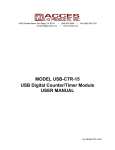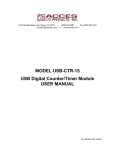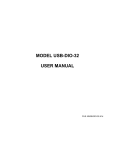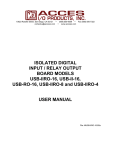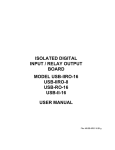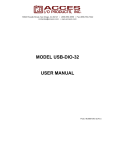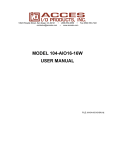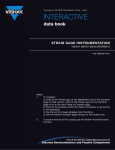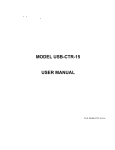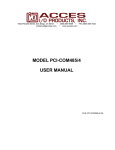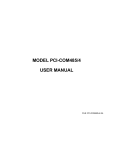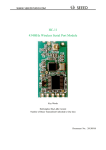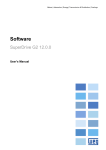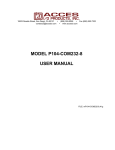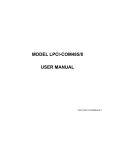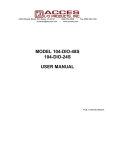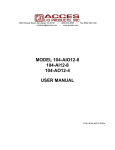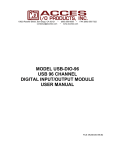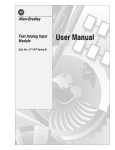Download USB 16-CHANNEL ANALOG INPUT MODULE
Transcript
10623 Roselle Street, San Diego, CA 92121 y (858) 550-9559 y Fax (858) 550-7322 [email protected] y www.accesio.com USB 16-CHANNEL ANALOG INPUT MODULE MODEL USB-AI12-16x USER MANUAL File: MUSB-AI12-16x.B1a Notice The information in this document is provided for reference only. ACCES does not assume any liability arising out of the application or use of the information or products described herein. This document may contain or reference information and products protected by copyrights or patents and does not convey any license under the patent rights of ACCES, nor the rights of others. IBM PC, PC/XT, and PC/AT are registered trademarks of the International Business Machines Corporation. Printed in USA. Copyright 2008 by ACCES I/O Products, Inc. 10623 Roselle Street, San Diego, CA 92121. All rights reserved. WARNING!! ALWAYS CONNECT AND DISCONNECT YOUR FIELD CABLING WITH THE COMPUTER POWER OFF. ALWAYS TURN COMPUTER POWER OFF BEFORE INSTALLING A BOARD. CONNECTING AND DISCONNECTING CABLES, OR INSTALLING BOARDS INTO A SYSTEM WITH THE COMPUTER OR FIELD POWER ON MAY CAUSE DAMAGE TO THE I/O BOARD AND WILL VOID ALL WARRANTIES, IMPLIED OR EXPRESSED. 2 Manual USB-AI12-16x Warranty Prior to shipment, ACCES equipment is thoroughly inspected and tested to applicable specifications. However, should equipment failure occur, ACCES assures its customers that prompt service and support will be available. All equipment originally manufactured by ACCES which is found to be defective will be repaired or replaced subject to the following considerations. Terms and Conditions If a unit is suspected of failure, contact ACCES' Customer Service department. Be prepared to give the unit model number, serial number, and a description of the failure symptom(s). We may suggest some simple tests to confirm the failure. We will assign a Return Material Authorization (RMA) number which must appear on the outer label of the return package. All units/components should be properly packed for handling and returned with freight prepaid to the ACCES designated Service Center, and will be returned to the customer's/user's site freight prepaid and invoiced. Coverage First Three Years: Returned unit/part will be repaired and/or replaced at ACCES option with no charge for labor or parts not excluded by warranty. Warranty commences with equipment shipment. Following Years: Throughout your equipment's lifetime, ACCES stands ready to provide on-site or in-plant service at reasonable rates similar to those of other manufacturers in the industry. Equipment Not Manufactured by ACCES Equipment provided but not manufactured by ACCES is warranted and will be repaired according to the terms and conditions of the respective equipment manufacturer's warranty. General Under this Warranty, liability of ACCES is limited to replacing, repairing or issuing credit (at ACCES discretion) for any products which are proved to be defective during the warranty period. In no case is ACCES liable for consequential or special damage arriving from use or misuse of our product. The customer is responsible for all charges caused by modifications or additions to ACCES equipment not approved in writing by ACCES or, if in ACCES opinion the equipment has been subjected to abnormal use. "Abnormal use" for purposes of this warranty is defined as any use to which the equipment is exposed other than that use specified or intended as evidenced by purchase or sales representation. Other than the above, no other warranty, expressed or implied, shall apply to any and all such equipment furnished or sold by ACCES. 3 Manual USB-AI12-16x TABLE OF CONTENTS Chapter 1: Introduction..................................................................................................................................... 5 Features .......................................................................................................................................................... 5 Applications.................................................................................................................................................... 5 Functional Description .................................................................................................................................. 5 Figure 1-1: Block Diagram........................................................................................................................... 6 Analog Inputs.............................................................................................................................................. 7 A/D Start ...................................................................................................................................................... 7 Oversample ................................................................................................................................................. 8 Calibration................................................................................................................................................... 8 Figure 1-2: System Calibration Utility screenshot 1 (setup)........................................................................ 9 Figure 1-3: System Calibration Utility screenshot 2 (range select) ............................................................. 9 Figure 1-4: System Calibration Utility screenshot 3 (offset)...................................................................... 10 Figure 1-5: System Calibration Utility screenshot 4 (gain) ........................................................................ 10 Figure 1-6: System Calibration Utility screenshot 5 (confirmation) ........................................................... 11 Figure 1-7: System Calibration Utility screenshot 6 (finish and save)....................................................... 11 Digital I/O................................................................................................................................................... 11 Counter/Timer ........................................................................................................................................... 11 Ordering Guide............................................................................................................................................. 12 12-Bit Models ............................................................................................................................................ 12 16-Bit Models ............................................................................................................................................ 12 Model Options .............................................................................................................................................. 12 Included with your board ............................................................................................................................ 12 Optional accessories................................................................................................................................... 12 Chapter 2: Installation..................................................................................................................................... 13 Software CD Installation.............................................................................................................................. 13 Hardware Installation................................................................................................................................... 13 Chapter 3: Hardware Details........................................................................................................................... 14 Option Selection........................................................................................................................................... 14 Figure 3-1: Option Selection Map.............................................................................................................. 14 USB Connector (P1)..................................................................................................................................... 15 Embedded USB Connector (P4) ................................................................................................................. 15 LED ................................................................................................................................................................ 15 DC Power Jack (Optional) ........................................................................................................................... 15 68-PIN I/O CONNECTOR (J1) ...................................................................................................................... 15 Chapter 4: USB Address Information ............................................................................................................ 16 Chapter 5: Programming ................................................................................................................................ 17 Sample Programs......................................................................................................................................... 17 Figure 5-1: DIO Sample screenshot 1....................................................................................................... 17 Figure 5-2: DIO Sample screenshot 2....................................................................................................... 18 Figure 5-3: Analog Input Sample screenshot............................................................................................ 18 Chapter 6: Connector Pin Assignments ....................................................................................................... 19 Chapter 7 Specifications................................................................................................................................. 20 Analog Inputs ............................................................................................................................................... 20 Digital I/O ...................................................................................................................................................... 20 Counter/Timer............................................................................................................................................... 21 Environmental .............................................................................................................................................. 21 Appendix A: Counter/Timer........................................................................................................................... 22 Operational Modes....................................................................................................................................... 22 Customer Comments ...................................................................................................................................... 24 4 Manual USB-AI12-16x Chapter 1: Introduction This USB based Data Acquisition Module is an ideal solution for adding portable, easy-to-install high-speed analog input and digital I/O capabilities to any computer with a USB port. The unit is a USB 2.0 high-speed device and requires a USB 2.0 port to function. Features z z z z z z z z z z z z z z z z High-speed USB 2.0 device 12-bit resolution Sampling rate USB-AI12-16A 500Ksamples/sec (maximum aggregate) USB-AI12-16 250Ksamples/sec (maximum aggregate) USB-AI12-16E 100Ksamples/sec (maximum aggregate) 16 single-ended or 8 differential analog inputs (software selectable) System Calibration Program provided to calibrate entire system Calibration Hardware USB-AI12-16A Calibrated real-time output for offset/gain errors USB-AI12-16 NONE USB-AI12-16E NONE Ranges of 0-1V, 0-2V, 0-5V, 0-10V, ±1V, ±2V, ±5V, ±10V (software selectable per channel) A/D Start sources: Software, Timer, and External Trigger (rising or falling edge; software selectable) A/D Modes: Single Channel or Scan Noise reduction with Channel Oversampling Over-voltage protection of -40V to +55V 16 high-current Digital I/O lines 16-bit programmable counter/timer PC/104 module size and mounting compatibility Small (4" x 4" x 1.25") rugged industrial enclosure Miniature USB connector for embedded applications Applications z z z z Equipment monitoring Environmental measurements Embedded data acquisition Education/Laboratory Functional Description This product is a USB-based Analog to Digital converter board with 16 single-ended or 8 differential analog inputs. Inputs can either be voltages or optionally 4-20mA. The board is capable of sampling speeds up to 500K, 250K or 100K samples/sec (depending on model). Sampling can be enabled/disabled via an I/O connector pin by an external signal. Analog input channels are enabled as a consecutive set by software. Each channel within the set is independently configured by software to accept one of eight different analog input ranges. Analog to digital conversion starts or “A/D starts” are issued one of three ways: Software Start, Timer Start, or External Trigger Start. A/D starts are software configured to be either rising or falling edge. Additionally, A/D starts are software configured to be Single Channel or Scan. Single Channel samples data once from the next consecutive channel within the enabled set. A Scan samples data from all channels within the set at the fastest possible rate. To minimize noise, the board implements a technique called Oversampling. High accuracy is achieved with a real-time 5 Manual USB-AI12-16x internal calibration system (or software calibration, depending on model) which allows the card to adjust for offset/gain errors at runtime, giving a more precise reading. Also provided are 16 Digital I/O lines in 2 groups of 8 lines. Both Digital I/O bytes are individually software selectable as input or output. A fully programmable 8254 16-bit counter is provided with a maximum input frequency of 10MHz. The clock, gate (inputs) and output can be accessed externally for extended functionality. The complete unit is designed for use in rugged industrial environments but is compact enough to fit nicely onto any desk or testing station. The board is PC/104 sized (3.550 by 3.775 inches) with mounting capability and ships standard inside a steel powder-coated enclosure with an anti-skid bottom. Figure 1-1: Block Diagram 6 Manual USB-AI12-16x Analog Inputs There are a total of 16 single-ended or 8 differential analog inputs on this board. A consecutive set of channels are enabled/disabled by software. This set of channels is constructed by a start and end channel. Sampling begins on the start channel and continues through every successive channel until the end channel is sampled. Once the end channel has been sampled, the process repeats again from the start channel. If only one channel is being sampled, the start and end channels would be the same. Each channel within the set is individually software configured as either single-ended or differential. This board allows a mix of both single-ended and differential inputs. One must note, however, that a differential signal requires a pair of channels. Thus, when channel 0 is programmed as a differential input, both channels 0 and 8 are used and not available as singled-ended inputs. Refer to the connector pin assignment chapter for singleended and differential pair inputs. Optionally, resistors can be factory installed on selected channels to allow for 4-20mA or 1050mA analog inputs. Again, a mix of single-ended and differential inputs are possible but they are factory configured as static (hardware dependent) and cannot be changed by software. 8 input ranges, 4 bipolar and 4 unipolar, are selectable by software for each individual channel. This channel-by-channel flexibility allows for up to 8 different input ranges being acquired on a single board. The unipolar ranges are 0-1V, 0-2V, 0-5V, and 0-10V. The bipolar ranges are ±1, ±2V, ±5V, and ±10V. Each channel input has a slight positive bias to facilitate measurement of signals close to analog ground (no signal information is lost due to negative offset of the ADC). Each channel input has an over-voltage protection of -40V to +55V. A/D Start This board offers three software selectable sources for A/D Start: Software Start, Timer Start, and External Start Trigger. Software Start generates an A/D Start every time the software command is issued. The maximum frequency for a Software Start is roughly 4KHz. Timer Start uses the on-board timer to generate an A/D Start. Frequencies ranging from 2.33 * 10-3Hz to 500KHz are possible with Timer Start. External Start Trigger uses the External Trigger pin on the connector to generate an A/D Start. Frequencies up to 500KHz are allowed for External Start Trigger. A/D Start is also software configured as rising or falling edge. Furthermore, it can be disabled by driving the A/D Start Enable pin on the connector low. By default, this signal is pulled high and A/D Start is enabled. If A/D Start Enable goes low during a conversion, the current channel (plus any oversampling; refer to the Oversample section) will complete all its conversions before A/D Start is disabled. Once A/D Start Enable returns high, conversions will begin on the next successive channel within the enabled set upon the following A/D Start. An A/D Start can be one of two software selectable types for this board: Single Channel or Scan. A/D Starts that are Single Channel sample one channel within the enabled set per A/D Start. This allows for total control over the time skew between channels. Scan, on the other hand, will sample all the channels within the enabled set per A/D Start. Channels are sampled at 500KHz, 250KHz, or 100KHz (depending on model) to minimize the time skew between channels. 7 Manual USB-AI12-16x Oversample Oversampling is a technique which continuously samples a channel multiple times at the maximum A/D speed of your particular model. Quickly taking several samples from the same channel allows the signal to be averaged. Averaging a signal can greatly reduce the noise injected by both the signal and the board/system. The oversample range is from 0 to 255 (software selectable) and applies to every channel within the enabled set. A channel is always sampled once plus the number of oversamples that was configured. Therefore an oversample of 0 will sample a channel once (initial sample plus 0 oversamples), oversample of 1 will sample a channel twice (initial sample plus 1 oversample), up to an oversample of 255 which will sample a channel 256 times (initial sample plus 255 oversamples). Each channel's oversamples are taken before sampling begins on the next consecutive channel within the enabled set. Calibration All ADC's suffer from offset and gain errors. To account for this, the board implements calibration methods to adjust for the offset/gain errors. This is particularly helpful as aging occurs and/or operating temperature changes. There are two methods available to calibrate: Board Calibration and System Calibration. Board Calibration uses two on-board known reference voltages that are accessible by software. The first reference voltage measures analog ground while the second reference voltage measures slightly below 10V (refer to the specification for exact values). The results of sampling both reference voltages can then be used to compare against the known values specified for each reference. Differences between the sampled value and the known value provides offset/gain error information for correcting these errors in hardware. System Calibration uses the System Calibration program provided with the board. The System Calibration program is methodically the same as Board Calibration except that the reference voltages are supplied by the user on analog input channel 0. The advantage of System Calibration over Board Calibration is the ability to calibrate out offset, gain, and other errors for the entire system. The system can include such devices as sensors, signals conditioners, etc. These components contribute to errors in the system. Calibrating using the System Calibration program accounts for the gain/offset errors of the board AND the errors from the system it is connected to. Only “A” models contain hardware to calibrate the output of the ADC. This hardware can be used by both Board Calibration and System Calibration. Either method creates a file containing offset, gain, and other errors (refer to the software reference manual for the file format). This calibrated information within the file is then loaded onto the board and used by calibration hardware. At this point, the ADC output is real-time with respect to the last time either Board or System Calibration was run. There also exists a function in software that, when called, will automatically run Board Calibration and store the calibrated information onto the board. For optimum calibrated data, calibration should be repeated anytime the temperature or environment changes. Board Calibration can be performed in milliseconds and is recommended to be performed periodically. 8 Manual USB-AI12-16x Figure 1-2: System Calibration Utility screenshot 1 (setup) Figure 1-3: System Calibration Utility screenshot 2 (range select) 9 Manual USB-AI12-16x Figure 1-4: System Calibration Utility screenshot 3 (offset) Figure 1-5: System Calibration Utility screenshot 4 (gain) 10 Manual USB-AI12-16x Figure 1-6: System Calibration Utility screenshot 5 (confirmation) Figure 1-7: System Calibration Utility screenshot 6 (finish and save) Digital I/O There are 16 Digital I/O lines (DIO0 to DIO15) available on this board. Both the low byte (DIO0-DIO7) and high byte (DIO8-DIO15) can be individually software configured as inputs or outputs. Each DIO line is buffered and capable of sourcing 32mA or sinking 64mA. Be sure to consult the Power section for total power limitations before operation. By default the DIO lines are pulled up with a 10KΩ resistor to 5V. DIO lines can also be factory configured as pulled down. Counter/Timer A fully programmable 8254 16-bit counter is provided with the Counter Gate, Counter Clock, and Counter Output signals brought out to the connector. All three signals are buffered and capable of sourcing 32mA or sinking 64mA. Be sure to consult the Power section for total 11 Manual USB-AI12-16x power limitations before operation. The Counter Gate, Counter Clock, and Counter Output are pulled up with a 10KΩ resistor to 5V. The clock input is software selectable between an internal 10MHz clock and the external Counter Clock. The maximum allowed frequency for the clock is 10MHz. The highly versatile 8254 contains three independent counter/timers. Counter 0 is available for general purpose use as described above. Counters 1 and 2 are dedicated for use in timing A/D starts. Ordering Guide This manual primarily describes the 12-Bit versions of this family. 16-Bit models are described in their own manual, however, they are listed here for your reference. 12-Bit Models • • • USB-AI12-16A - Full feature version, 12-Bit 500kHz A/D, with real-time-calibration USB-AI12-16 - Standard version, 12-Bit 250kHz, with software calibration USB-AI12-16E – Economy version, 12-Bit 100kHz, with software calibration 16-Bit Models • • USB-AI16-16A - Full feature version, 16-Bit 500kHz, with real-time-calibration USB-AI16-16E - Economy version, 16-Bit 250kHz, with software calibration Model Options • • • • • -P -OEM -DIN -T -S0x External AC/DC adapter (power jack/regulator installed) Board only (no enclosure) DIN rail mounting provision Extended Temperature Operation (-40° to +85°C) “x” = special number designator (contact factory) 4-20mA or 10-50mA inputs 16 current inputs when factory configured as single-ended 8 current inputs when factory configured as differential DIO lines can be configured with pull down resistors Included with your board The following components are included with your shipment. Please take time now to ensure that no items are damaged or missing. 1. 2. 3. 4. USB-AI12-16x (unit installed in labeled enclosure) 6’ USB cable Software Master CD (PDF user manual installed with product package) Printed USB I/O Quick-Start Guide Optional accessories • • • C68PS18L - 68-Pin SCSI 18” shielded cable with one-touch latches STB-68 - Screw Terminal Board (mounted on standoffs) CUSB-MINI – 6’ USB Cable with type A connector and mini “OTG” connector for embedded applications (mates with P4 on the board) 12 Manual USB-AI12-16x Chapter 2: Installation Software CD Installation The software provided with this board is contained on one CD and must be installed onto your hard disk prior to use. To do this, perform the following steps as appropriate for your operating system. Substitute the appropriate drive letter for your drive where you see D: in the examples below. WIN98/Me/2000/XP/2003 a. b. c. Place the CD into your CD-ROM drive. The CD should automatically run the install program. If the install program does not run, click START | RUN and type BGLQR?JJ, click OK or press -. Follow the on-screen prompts to install the software for this board. LINUX a. Please refer to linux.htm on the CD-ROM for information on installing under linux. Hardware Installation Please install the software package before plugging the hardware into the system. The board can be installed in any USB 2.0 port. Please refer to the USB I/O Quick Start Guide which can be found on the CD, for specific, quick steps to complete the hardware and software installation. 13 Manual USB-AI12-16x Chapter 3: Hardware Details Option Selection You may also refer to the setup program installed from the CD provided with the board. The only user selectable hardware option available is VUSB vs. VEXT which selects between USB powered or Externally powered. Figure 3-1: Option Selection Map 14 Manual USB-AI12-16x USB Connector (P1) The USB connector available via the outside of the enclosure is a Type B and mates with the six foot cable provided. The USB port provides communication signals along with +5 VDC power. The board can be powered from the USB port or an optional external power supply can be used. Embedded USB Connector (P4) In applications where the OEM (board only, no enclosure) version of this board is used, it may be desirable to use the miniature USB connector onboard, which is next to and in parallel with the Type B connector. LED The LED on the front of the enclosure is used to indicate power and data transmissions. When the LED is in an illuminated steady green state, this signifies that the board is successfully connected to the computer and has been detected and configured by the operating system. When the LED flashes continuously, this signifies that there is data being transmitted over the USB bus. DC Power Jack (Optional) Please note, not all boards will contain this option. This is an option for high current applications when more current is needed than what your computer can provide on the USB port (typically 500 mA). The DC jack has a 2.00mm post on board and is designed to be used with the 9 VDC AC/DC external power supply that ships with this option. The voltage regulator on board regulates the 9 VDC and provides 5 VDC to the onboard circuitry. When using external power, switch the jumper located near the USB connector to VEXT, otherwise when the jumper is in the VUSB position current is drawn from the USB port (please consult the option selection map for a visual reference). 68-PIN I/O CONNECTOR (J1) The I/O is accessed via a 68-pin female SCSI Pin in Socket type connector with one-touch lock latches. Detailed pin assignments are listed in chapter 6, as well as a handy reference of pin functions printed on the enclosure label. 15 Manual USB-AI12-16x Chapter 4: USB Address Information Use the provided driver to access the USB board. This driver will allow you to determine how many supported USB devices are currently installed, and each device’s type. This information is returned as a Vendor ID (VID), Product ID (PID) and Device Index. The board’s VID is “0x1605", and its PID is “0x8040". The Device Index is determined by how many of the device you have in your system, and can provide a unique identifier* allowing you to access a specific board at will. * See the Software Reference Manual, installed on your system along with the board support package, for more information. 16 Manual USB-AI12-16x Chapter 5: Programming The driver software provided with the board uses a 32-bit .dll front end compatible with any Windows programming language. Samples provided in Borland C++Builder, Borland Delphi, Microsoft Visual Basic, and Microsoft Visual C++ demonstrate use of the driver. Many functions are provided by the driver in Windows. These functions will allow you to read or write to the board. In addition, counter-timer functionality and board-level functions complete the driver package. For detailed information on each function refer to the .html Driver Manual located in the Win32 directory for this board. unsigned long GetDevices(void ) unsigned long QueryDeviceInfo(DeviceIndex, pPID, pName, pDIOBytes, pCounters) Sample Programs Sample programs are useful to check out initial operation of the board as well as aiding in the understanding of the programming techniques used as source code is always provided. This first screenshot illustrates what controls and indicators are provided for the digital I/O portion of the board. The + indicates the bit is high, or a 1. You would read a high on the associated connector pin with a voltage meter.. Figure 5-1: DIO Sample screenshot 1 17 Manual USB-AI12-16x This screenshot shows Port A (DIO bits 0 through 7) has been selected as Outputs, with even numbered bits being controlled low (sinking current), as indicated by the black O. Figure 5-2: DIO Sample screenshot 2 Figure 5-3: Analog Input Sample screenshot 18 Manual USB-AI12-16x Chapter 6: Connector Pin Assignments The I/O connector is a 68-pin Type 2 SCSI female, right-angle type with quick-release “one-touch” locking latches, which protrudes through a cutout in the module’s enclosure. Pin Signal Name Description Pin Signal Name Description 1 Ch0(SE)/Ch0+(DIFF) Channel 0 Singled-ended or Channel 0 differential non-inverting input 35 Ch8(SE)/Ch0-(DIFF) Channel 8 Single-ended or Channel 0 differential inverting input 2 AGND Analog Ground 36 AGND Analog Ground 3 Ch1(SE)/Ch1+(DIFF) Channel 1 Singled-ended or Channel 1 differential non-inverting input 37 Ch9(SE)/Ch1-(DIFF) Channel 9 Single-ended or Channel 1 differential inverting input 4 AGND Analog Ground 38 AGND Analog Ground 5 Ch2(SE)/Ch2+(DIFF) Channel 2 Singled-ended or Channel 2 differential non-inverting input 39 Ch10(SE)/Ch2-(DIFF) Channel 10 Single-ended or Channel 2 differential inverting input 6 AGND Analog Ground 40 AGND Analog Ground 7 Ch3(SE)/Ch3+(DIFF) Channel 3 Singled-ended or Channel 3 differential non-inverting input 41 Ch11(SE)/Ch3-(DIFF) Channel 11 Single-ended or Channel 3 differential inverting input 8 AGND Analog Ground 42 AGND Analog Ground 9 Ch4(SE)/Ch4+(DIFF) Channel 4 Singled-ended or Channel 4 differential non-inverting input 43 Ch12(SE)/Ch4-(DIFF) Channel 12 Single-ended or Channel 4 differential inverting input 10 AGND Analog Ground 44 AGND Analog Ground 11 Ch5(SE)/Ch5+(DIFF) Channel 5 Singled-ended or Channel 5 differential non-inverting input 45 Ch13(SE)/Ch5-(DIFF) Channel 13 Single-ended or Channel 5 differential inverting input 12 AGND Analog Ground 46 AGND Analog Ground 13 Ch6(SE)/Ch6+(DIFF) Channel 6 Singled-ended or Channel 6 differential non-inverting input 47 Ch14(SE)/Ch6-(DIFF) Channel 14 Single-ended or Channel 6 differential inverting input 14 AGND Analog Ground 48 AGND Analog Ground 15 Ch7(SE)/Ch7+(DIFF) Channel 7 Singled-ended or Channel 7 differential non-inverting input 49 Ch15(SE)/Ch7-(DIFF) Channel 15 Single-ended or Channel 7 differential inverting input 16 AGND Analog Ground 50 AGND Analog Ground 17 to 21 Not used 51 to 55 Not used 22 GND Digital Ground 56 GND Digital Ground 23 DIO14 Digital I/O Bit 14 (pulled-up) 57 DIO15 Digital I/O Bit 15 (Msb; pulled-up) 24 DIO12 Digital I/O Bit 12 (pulled-up) 58 DIO13 Digital I/O Bit 13 (pulled-up) 25 DIO10 Digital I/O Bit 10 (pulled-up) 59 DIO11 Digital I/O Bit 11 (pulled-up) 26 DIO8 Digital I/O Bit 8 (pulled-up) 60 DIO9 Digital I/O Bit 9 (pulled-up) 27 DIO6 Digital I/O Bit 6 (pulled-up) 61 DIO7 Digital I/O Bit 7 (pulled-up) 28 DIO4 Digital I/O Bit 4 (pulled-up) 62 DIO5 Digital I/O Bit 5 (pulled-up) 29 DIO2 Digital I/O Bit 2 (pulled-up) 63 DIO3 Digital I/O Bit 3 (pulled-up) 30 DIO0 Digital I/O Bit 0 (Lsb; pulled-up) 64 DIO1 Digital I/O Bit 1 (pulled-up) 31 GND Digital Ground 65 GND Digital Ground 32 Counter Output Output from 8254 ctr/tmr (pulled-up) 66 GND 33 Counter Clock 8254 counter/timer clock input (pulled-up) 67 A/D Start Enable 34 Counter Gate 8254 counter/timer gate input (pulled-up; active-high) 68 External Trigger 19 Digital Ground Enable Analog to Digital Conversion Starts (pulled-up; active-high) External Analog to Digital Conversion Start Trigger (pulled-up; software selectable rising/falling edge ) Manual USB-AI12-16x Chapter 7 Specifications Analog Inputs ADC Type Sampling rate USB-AI12-16A USB-AI12-16 USB-AI12-16E Resolution Number of channels Bipolar ranges Unipolar ranges 4-20mA 10-50mA Board Calibration System Calibration Calibration Hardware USB-AI12-16A USB-AI12-16 USB-AI12-16E Input impedance A/D Start Sources A/D Start Enable A/D Start Types Channel Oversampling Overvoltage protection Crosstalk Successive approximation 500Ksamples/sec (maximum aggregate) 250Ksamples/sec (maximum aggregate) 100Ksamples/sec (maximum aggregate) 12-bit 16 single-ended or 8 differential (software selectable) ±1V, ±2V, ±5V, ±10V (software selectable) 0-1V, 0-2V, 0-5V, 0-10V (software selectable) Factory installed (optional) Factory installed (optional) VREF LOW: AGND VREF HIGH: 9.90V ± 0.0299V Program provided to calibrate entire system Calibrated real-time output for offset/gain errors NONE NONE 1MΩ Software Start, Timer Start, and External Start Trigger (rising or falling edge; software selectable) Externally supplied (pulled-up; active-high ) Single Channel or Scan (software selectable) 0-255 consecutive samples/channel (software selectable) -40 to +55V No crosstalk present below 400KHz -60dB @ 500KHz Digital I/O Lines Input voltage Input current Output voltage Output current 16, programmable as inputs or outputs in groups of 8 (pulled-up) Logic low: 0V(min) to 0.8V(max) Logic high: 2V(min) to 5V(max) ±20μA (max) Logic low: 0V(min) to 0.55V(max) Logic high: 2V(min) to 5V(max) Logic low 64mA(max) sink Logic high 32mA(max) source 20 Manual USB-AI12-16x Counter/Timer Type Available Counters Input Frequency Counter size Clock Clock Period Clock Pulse Width High Clock Pulse Width Low Gate Output 82C54 programmable interval counter Counter 0 10MHz (max) 16-bit Internal 10MHz or Externally supplied (software selectable; pulled-up) 100ns (min) 30ns (min) 40ns (min) Externally supplied (pulled-up; active-high) External (pulled-up) Input/Output Voltage/Current Same as Digital I/O Environmental Operating Temperature Storage Temperature Humidity Board Dimensions 0° to +70°C, optional -40° to +85°C -40° to +105°C 5% to 90% RH, without condensation PC/104 format, 3.550” by 3.775” and mounting holes Power required +5V at 330mA typ1 1 USB 2.0 spec defines a device in terms of a unit load. A unit load is defined to be 100mA. Devices drawing an absolute maximum of one unit load is considered to be low-powered and devices drawing an absolute maximum of five unit loads is considered to be high-powered. Because this spec is not strictly adhered to, it is best to verify the USB port's power capabilities before operation. This card, according to the USB 2.0 spec, is a high powered device. An optional external power supply can be ordered if the USB port cannot support high powered devices. If using more than a total of 500mA, use optional 9 VDC (on board voltage regulator outputs +5 VDC to card) external power supply and remove VUSB jumper and place jumper on VEXT. Then plug in external power before plugging into USB port . This option will give you a total of 1000mA available. 21 Manual USB-AI12-16x Appendix A: Counter/Timer This board contains a 82C54 16-bit counter/timer. It can be programmed to any count as low as 1 or 2, and up to 65,536, depending on the mode chosen. For those interested in more detailed information, a full description can be found in the Intel (or equivalent manufacturer's) data sheet, provided in the /chipdocs directory on the Software Master CD. In addition, the driver and firmware on the board requires a full 16-bit load operation; do not select “low -byte only” or “high-byte only” modes for the counters. Additional low-level information on the 82C54 can be found on the Software Master CD in the /chipdocs directory. Operational Modes The 8254 modes of operation are described in the following paragraphs to familiarize you with the versatility and power of this device. For those interested in m ore detailed information, a full description of the 8254 programmable interval timer can be found in the Intel (or equivalent manufacturers') data sheets. The following conventions apply for use in describing operation of the 8254 : Clock: A positive pulse into the counter's clock input Trigger: A rising edge input to the counter's gate input Counter Loading: Programming a binary count into the counter Mode 0: Pulse on Terminal Count After the counter is loaded, the output is set low and will remain low until the counter decrements to zero. The output then goes high and remains high until a new count is loaded into the counter. A trigger enables the counter to start decrementing. Mode 1: Retriggerable One-Shot The output goes low on the clock pulse following a trigger to begin the one-shot pulse and goes high when the counter reaches zero. Additional triggers result in reloading the count and starting the cycle over. If a trigger occurs before the counter decrements to zero, a new count is loaded. This forms a retriggerable one-shot. In mode 1, a low output pulse is provided with a period equal to the counter count-down time. Mode 2: Rate Generator This mode provides a divide-by-N capability where N is the count loaded into the counter. When triggered, the counter output goes low for one clock period after N counts, reloads the initial count, and the cycle starts over. This mode is periodic, the same sequence is repeated indefinitely until the gate input is brought low. This mode also works well as an alternative to mode 0 for event counting. 22 Manual USB-AI12-16x Mode 3: Square Wave Generator This mode operates like mode 2. The output is high for half of the count and low for the other half. If the count is even, then the output is a symmetrical square wave. If the count is odd, then the output is high for (N+1)/2 counts and low for (N-1)/2 counts. Periodic triggering or frequency synthesis are two possible applications for this mode. Note that in this mode, to achieve the square wave, the counter decrements by two for the total loaded count, then reloads and decrements by two for the second part of the wave form. Mode 4: Software Triggered Strobe This mode sets the output high and, when the count is loaded, the counter begins to count down. When the counter reaches zero, the output will go low for one input period. The counter must be reloaded to repeat the cycle. A low gate input will inhibit the counter. Mode 5: Hardware Triggered Strobe In this mode, the counter will start counting after the rising edge of the trigger input and will go low for one clock period when the terminal count is reached. The counter is retriggerable. The output will not go low until the full count after the rising edge of the trigger. 23 Manual USB-AI12-16x Customer Comments If you experience any problems with this manual or just want to give us some feedback, please email us at: [email protected]. Please detail any errors you find and include your mailing address so that we can send you any manual updates. 10623 Roselle Street, San Diego CA 92121 Tel. (858)550-9559 FAX (858)550-7322 www.accesio.com 24 Manual USB-AI12-16x
























